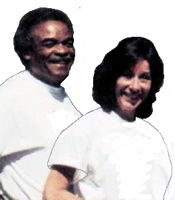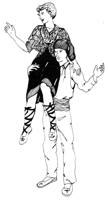
|
Folk Dance Federation of California, South, Inc.
|

|
CLICK AN IMAGE TO ENLARGE
As with the costume and other aspects of her culture, the dance and music of France show considerable regional variation. One grouping of the dances is by general region, and includes those of Brittany, Bourbonnais, Provence, Alsace, and the Pyrenees.
Brittany
Records of dance in Brittany go back to the mid-1500s with descriptions of lively, leaping steps of Triori, the special dance of lower Brittany. Passepied, the dance of upper Brittany, had a more sedate style. In that era, dancing could be seen at most local fetes, weddings, "pardons" (the festivals of the local saints), and at certain points in the agricultural calendar. Typically, the inauguration of a new threshing floor called for a dance to celebrate its completion (so the dancers could help to tamp down the new floor?). At weddings, women danced alone at the beginning of the ceremony, to be joined by the men only after the women had done several turns around the floor. Participants at St. John's Eve dances (held on Midsummer's Eve) assembled around a fire to the call of a peculiar instrument made of rushes stretched across the opening of a water-filled cauldron. The rushes were pulled back and forth across the opening, producing a sound that could be heard for miles and miles (and, supposedly, by the souls of the dead, which would come back to warm themselves by the Midsummer's Eve bonfire). There also were dances reminiscent of pagan rituals, such as the Gabadad, danced in memory of a witch's sabbath (perhaps showing remnants of a fertility rite). The original purpose and symbolism of many of the dances were lost as they were shunted back and forth from country to court dances. In upper Brittany, many of the country dances disappeared in the shuffle.
Happily, Upper Brittany (Western Brittany) has kept a number of her country dances. The three main styles of dance extant today are the Vannetais, the Hill, and the Basse-Cornouaille.The first and last are characterized by a smooth, gentle style and simple translations between step patterns. One of the classical Basse-Cornouaille style dances, the Gavotte, can be danced in either an open or closed round, and is often used as the first figure of a "bal" (or dance). The Jabado, another dance in this style, begins as a circle dance of four to eight dancers and evolves into a couple dance. The Vannetais style is similar to the Basse-Cornouaille, the main difference being the use of the arms as well as the legs in the movements. The Hill style, on the other hand, is characterized by quick, jerky movements. Music played on the "biniou" (bagpipe) and the "bombarde" (a type of oboe), or singing, accompanied the dancers.
Bourbonnais
Bourbonnais covers the area in the center of France where much of the culture carries heavy traces left by the ancient Gauls. Until the second part of the 19th century, the Bourrée, a calm and indolent dance descended from the Gauls, enjoyed much popularity. Later, it was replaced by the Quadrille.
This region boasts several mimetic dances, ritual dances, and special wedding round dances. Imitating different animals, the mimetic dances include the Chibrili and Chleb (copying the leaping movements of goats), the Pas de Loup (with furtive steps aping the slinky movements of wolves), and the Moutons (a chain dance imitating the confused movements of a flock of sheep).
Among the many ritual dances, one has a "hobby horse" as its central character. According to legend, the hobby horse was invented to "frighten off the English" when they were defeated in the suburbs of Montluçon, a village in the Bourbonnais province. The event has since been commemorated with a dance-drama in which dancers in medieval soldier's garb, including high-pointed head pieces fashioned of rushes, and swords, engage in a sword-fight dance in time to the music. One falls, mortally wounded, and the others flee. In more recent times, the fete became a spring festival. A sword dance is still done, but then the hobby horse is led to the church where he is fed oats before a high altar and given holy water to drink. The fete ends with a huge feast for all.
Wedding round dances (traditional Rondes or ring dances) had a special place in country wedding ceremonies, beginning just after the wedding banquet was finished. One round was danced encircling a cabbage, the symbol of fecundity, and another around a fire where the in-law's hats were tossed. Everyone was required to jump over the fire, with the bride being last in line (any symbolism here?).
Music for the dances was provided by the master musician, standing atop upturned barrels. He directed the "vielle" (hurdy-gurdy) and "musette" (bagpipe) players through the entire event.
The dances of Provence can be divided into four basic categories: those belonging to the trades (the Guild Dances); the "real" folk dances, danced by the people at fetes; dances of the court; and ritual dances, those considered traditional by rural folk and danced only on special occasions.
Guild Dances are many and varied, representing every trade imaginable. In Li Tisserand, a framework representing a "loom" is hung with ribbons. A man, the weaver, carries a "shuttle" in one hand and procedes to horizontally weave another ribbon in and out through the ribbons of the "loom." In Li Triho (the Vine Arbor), dancers promenade under leafy arches, and dance with movements imitating the picking and pressing of grapes. Other trade dances include La Civàia (the Oats), Li Jardinero (the Gardeners), and Les Bergères (the Spinners).
The "Real" folk dances are also many and varied, tending at times to fuse with other dance categories. Examples include Le Rigadoon, a round country dance in which the women dance around a ring counterclockwise, dancing with each man in turn (a mixer?), La Fricassio, a couple dance with a "lover's quarrel" theme (flirting, sulking, reconciliation), and Les Metalotes, a dance once danced by sailors on warships at Toulon. In many cases, it is the local "tambourinaires" (musicians) who act as the keepers of the traditional dances, appearing at all village festivals and providing music on the pipe and drum for the dancers.
Court dances, in some cases, began as "real" folk dances. They then became the rage at court, and finally returned to the "folk." Le Rigadoon, mentioned above, followed this pattern, having been created in Provence, then adopted by the courts in Paris and London, and then returned to the country. La Volto, a dance imported from Italy, whose main feature is a swirling leap done by the women, Farandole, a chain dance, and the Basse Danses (low dances) are included in this category.
In the Basse Danse, the dancers' feet do not leave the ground, imparting a serene, undulating character to the style. Over time, the sequences of steps and the relationship to the musical phrasing has been rigidly set. Certain steps are done at the beginning, the middle, and the end of each dance. The "rules" even specify how many times a given step can be done in a row! This has led to a fairly complex dance mode which has been studied and documented by a number of ethnic and other dance scholars over the years. One treatise was written as early as 1536 by Antonius de Arena. A more recent text dealing with the history and performance of these dances (and available in several local libraries) entitled, "The Dances of England and France from 1400-1600," was written by Mabel Dolmetch.
Ritual dances are done primarily on patron saint's days and during the Carnival season. In Li Coco (the Coconuts), male dancers wear coconut halves on their knees, elbows, chest and hands, clapping the shells on each other's bodies with those on their hands. Their faces are blackened and they are attended throughout by a ritual fool. In Li Fielove (the Spinners), male dancers wear white chemises with huge collars, floppy hats, and bells on their arms. Colored paper "sacks" lit by candles hang from their long staffs, lighting their way as they parade through the night, improvising verse and dances. Les Olivettes is one of the two sword dances know in France. In this dance, eight to sixteen "soldiers," and one Harlequin, dance. The soldiers form a "lock" of swords around the Harlequin, who then steps on it and is lifted to the soldiers' shoulder height.
Alsace
Alsace is the province of France bordering Germany. Here, a Germanic dialect is spoken. Traditional dances, once danced only to sung music, disappeared from this area by the 19th century, to be replaced first by the Polka and Valse, and later by the Mazurka and Schottische.
At one time, dances were done at all the fetes, those for all the stages of life and those for the many relations of the peasant to his land. Old customs and dances can only be seen now during the Messti fete in the Bas-Rhin and the Kilbe in the Haut-Rhin.
Dances in the easternmost part of this province (French Catalonia or Rousillon) show a distinct Mediterranean influence, while those in the west show a more Basque flavor. In the south, close to Spain, the woman is the "star" of the dance, with the man playing only a "supporting role."
In French Catalonia, an important feature of some dances is the lifting of the woman. After wedding dances, it is customary for the groom's nearest male relative to lift the bride and carry her to the bridal chamber for the first evening of the wedding. Many of the dances have romantic and/or playful themes. In the Bail dus Coumfits, the men buy artificial flowers and sugared almonds to give to their favorite partners during the dance. In the Bail de'l Ascoumbe (the Broom Dance), the man begins the dance with his arm around his partner's waist. There is one exception, and he begins the dance with a broom as a partner. As the dance progresses, he gives the broom to one of the women, and then runs away to dance with some other partner. The abandoned woman must dance with the broom until someone comes to claim her. At that point, she deposits the broom at the feet of another woman, who must repeat the cycle. This region also has a number of chain dances, and several special dances done only at Carnival time. Musical accompaniment is by the "cobla band," which includes a strident prime and a tenor (both woodwinds), a coronet, a brass band, and a string double bass.
Going to the west to the Lez Valley and Balaqueres, the music takes on elements of both the east and the west. Dances here include La Traversee (the Crossing), a country set dance danced with two or three couples per set, and the Bourrée (Stuffed), and the Castagne (the Chestnut), both carefree and energetic dances. There also are several "witches" dances, that always include a follow-the-leader and a ring dance section. One, Pelha ded Gat (the Cat's Skin), is danced entirely in a squatting posture, imitating the movements of a cat.
With this wealth of French dance tradition, it is heartening and exciting to know that there has been a recent revival of interest among the French people themselves. Most provinces have one or several groups dedicated to the study, preservation, and presentation of traditional dances. Perhaps, with their combined efforts, traditional French dancing will again be an integral part of life in that country.
Bibliography
- Alford, Violet. Dances of France. Vol. 3. Max Parrish & Co., London.
- Marcel-Dubois, Claudie and Andral, Marie. Dances of France. Vol. 1. Max Parrish & Co., London.
- Tennevin, Nicolette and Texier, Marie. Dances of France. Vol. 2. Max Parrish & Co., London.
Printed in Folk Dance Scene, December 1990.

